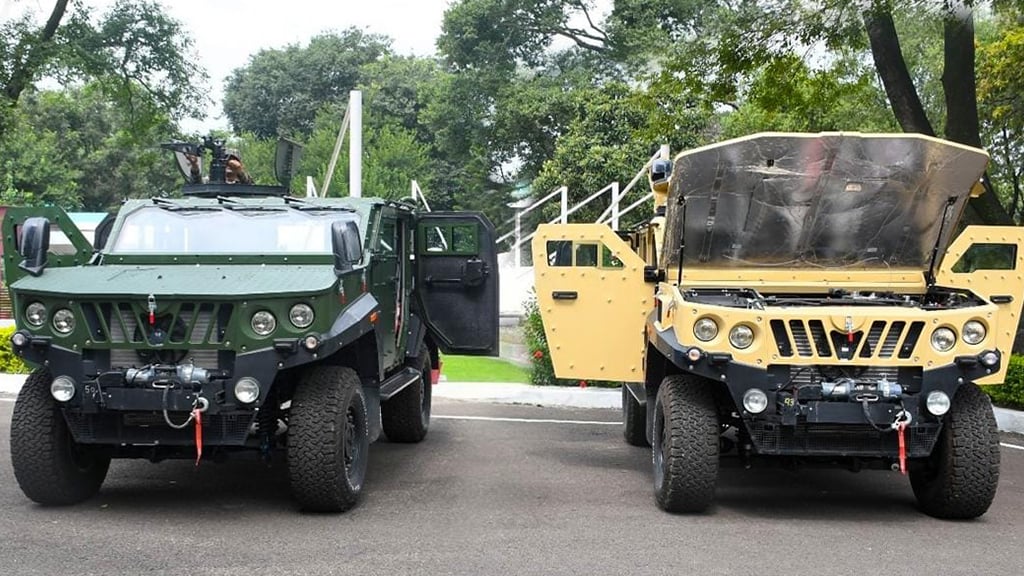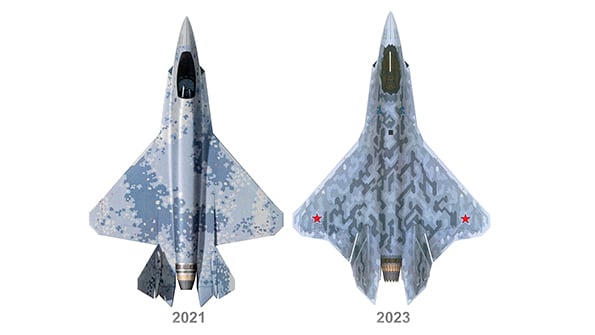Monthly Archives: January 2025
SOURCE: IDRW.ORG


Recent media reports suggesting that India is actively opposing Bangladesh’s prospective acquisition of JF-17 “Thunder” fighter jets have been contradicted by statements from the Indian Air Force (IAF). According to an IAF official speaking to idrw.org, the Indian government harbors no objections to this deal, refuting earlier narratives that portrayed India as vehemently against the procurement due to the aircraft’s origin from Pakistan and China, nations considered as adversaries by New Delhi.
Bangladesh has expressed interest in upgrading its air force capabilities, which currently rely on an aging fleet of F-7 and MiG-29 fighters. The JF-17, developed jointly by Pakistan and China, offers a modern alternative with its multi-role capabilities, which include air-to-air and air-to-ground missions. The interest was visibly demonstrated during a January visit by a high-ranking Bangladeshi military delegation, led by Lt. Gen. SM Qamarul Hassan, to Pakistan, where they showed keen interest in the JF-17 among other advanced defense systems.
Continue readingSOURCE: AFI


In a landmark event for India’s defence sector, the Anti Stealth VHF Radar, a product of collaboration between the Electronics and Radar Development Establishment (LRDE) and Bharat Electronics Limited (BEL), was officially launched today at BEL’s facility in Ghaziabad. This cutting-edge radar system, designed to counter stealth technology, represents a significant advancement in India’s Indigenous defence capabilities.
The newly unveiled radar system comes equipped with advanced surveillance features, including a ‘staring capability’ that allows for the detection of stealth targets at extended ranges. This technology is particularly noteworthy as it challenges the effectiveness of stealth aircraft and other low-observable platforms, providing the Indian military with a strategic edge in aerial surveillance and defense.
Continue readingSOURCE: AFI


In a decision that has defense enthusiasts buzzing with excitement, India has chosen ThyssenKrupp Marine Systems (TKMS) over Spain’s Navantia for its next-generation submarine procurement under Project 75-India (P75I). This choice marks a significant step forward in India’s naval capabilities, particularly in stealth technology and strategic maritime operations.
The submarine on offer from TKMS is described as a next-generation design, boasting a faceted hull that introduces Low Observable (LO) features. This design enhances the submarine’s stealth capabilities, making it the 5th generation of the diesel-electric attack submarine (SSK) with an emphasis on reducing its acoustic and radar signatures. The innovative hull shape is a radical departure from traditional designs, aiming to deflect sonar emissions, thereby making the submarine less detectable by modern anti-submarine warfare (ASW) systems.
Continue readingSOURCE: AFI


In a significant step forward for unmanned aerial vehicle technology, NewSpace Research and Technologies has unveiled a new type of long-endurance helicopter UAV. This innovative aircraft stands out with its streamlined design, featuring a tail rotor that enhances efficiency and stealth capabilities. The sleek, aerodynamic shape promises improved flight dynamics, making this UAV a potential game-changer in aerial surveillance and reconnaissance.
The helicopter UAV is not just about its unique design; it boasts a sophisticated tri-sensor gimbal camera system, which suggests capabilities for comprehensive day and night surveillance, thermal imaging, and high-resolution photography. This setup is ideal for various applications, including border security, disaster management, and military intelligence gathering, offering versatility in operational environments.
Continue readingSOURCE: AFI


In an exciting development for India’s aerospace sector, Prateek Dhawan, co-founder of DG Propulsion, has shared significant updates on the testing of their jet engines. The company, known for its pioneering work in propulsion technology, recently conducted a rigorous test where their engines operated in a vertical configuration for a full hour. This test not only included variable throttle adjustments to assess responsiveness but also maintained the engines at full throttle for the majority of the time.
Dhawan took to social media to share this milestone, although he noted with regret that the third video of this test session was not recorded. Despite this, the success of the test is a clear indicator of DG Propulsion’s advancements. “Jetsuits can absolutely be built in India now,” Dhawan confidently asserted, signaling a pivotal moment for the company and the Indian aerospace industry at large.
Continue readingSOURCE: AFI


The Indian Army’s affection for the Mahindra Armored Light Specialist Vehicle (ALSV) is no secret within defense circles, but the key to this admiration largely lies in the vehicle’s heart – a formidable 3.2-liter, 215 HP multi-fuel diesel engine sourced from Spanish technology. This engine, combined with a versatile 4/6 speed automatic transmission, has significantly enhanced the vehicle’s performance and adaptability on the battlefield.
The engine in question, a product of Spanish engineering excellence, offers a unique multi-fuel capability, allowing it to run on both NATO-grade diesel and other alternative fuels, ensuring operational flexibility in varied terrains and under diverse conditions. With a power output of 215 horsepower, the ALSV is designed to provide robust performance, whether it’s navigating through the rugged terrains of the Himalayas or the sandy stretches of the Thar Desert. The torque output, peaking at 500Nm, ensures that the vehicle can handle heavy loads and maintain mobility even in challenging conditions.
Continue readingSOURCE: Boom Supersonic


Boom Supersonic, the company building the world’s fastest airliner, Overture, today announced the successful first supersonic flight of its XB-1 demonstrator aircraft at the Mojave Air & Space Port in California. Boom designed, built, and flew the world’s first independently developed supersonic jet—the first civil supersonic jet made in America.
Flown by Boom Chief Test Pilot Tristan “Geppetto” Brandenburg, XB-1 entered the supersonic corridor and reached an altitude of 35,290 feet before accelerating to Mach 1.122 (652 KTAS or 750 mph) – breaking the sound barrier for the first time. Historically, supersonic aircraft have been the work of nation states, developed by militaries and governments. XB-1’s supersonic flight marks the first time an independently developed jet has broken the sound barrier.
Continue readingSOURCE: RAUNAK KUNDE / NEWS BEAT / IDRW.ORG

The Aeronautical Development Agency (ADA) has recalibrated the development schedule for the Twin Engine Deck-Based Fighter (TEDBF). This project had hit a snag due to delays in approvals from the Ministry of Defence (MoD). Classified as a ‘5th generation minus’ fighter jet, the TEDBF is poised to fulfil the Indian Navy’s need for a modern, carrier-capable combat aircraft.
After overcoming bureaucratic hurdles, ADA officials have announced a new timeline for the TEDBF. Originally, the first flight was aimed at 2026, but due to the extended review and approval processes, this has now been pushed to 2029. However, the induction into the Indian Navy’s fleet is set for a much later date, 2036, reflecting the extensive developmental and testing phases required for a deck-based fighter.
Continue readingSOURCE: RAUNAK KUNDE / NEWS BEAT / IDRW.ORG


The Defence Research and Development Organisation (DRDO) of India has reportedly commenced work on the development of the Rudram-IV, an advanced air-to-surface weapon system. Initial details about this missile system were first reported by idrw.org, and new information now sheds light on its specifications and intended mission profile.
The Rudram-IV is confirmed to have a range exceeding 300 kilometres, placing it in the category of long-range stand-off weapons. Interestingly, the missile is speculated to be lighter than the Rudram-III, which could allow for greater operational flexibility and enable it to target smaller and more precise objectives effectively.
Continue readingSOURCE: RAUNAK KUNDE / NEWS BEAT / IDRW.ORG


Hindustan Aeronautics Limited (HAL), India’s state-run aircraft manufacturer, is set to commence deliveries of the newly ordered Sukhoi-30 fighter jets to the Indian Air Force (IAF) in April 2027. This development follows the signing of a significant ?13,500-crore contract on December 12 with the Ministry of Defence for the procurement of 12 Sukhoi-30MKI aircraft, along with associated equipment.
The Sukhoi-30MKI jets under this contract will feature an Indigenous content of about 62.6%. The aircraft will be produced at HAL’s facility in Nashik, which has a history of manufacturing both MiG and Sukhoi aircraft under license, demonstrating HAL’s pivotal role in India’s defence production ecosystem.
Continue readingSOURCE: AFI


The Indian Light Combat Aircraft (LCA) Tejas Mk1A has undergone significant aerodynamic enhancements aimed at reducing transonic drag and boosting acceleration capabilities. Key among these modifications are the redesign of the inboard pylon’s leading edge and the reshaping of the chin pylon for the Laser Designation Pod (LDP).
The leading edge of the inboard pylon on the Tejas Mk1A now features a slight backward taper. This design change is not merely cosmetic but is engineered to streamline airflow over the pylon at transonic speeds, where the air moves at or near the speed of sound. By reducing the drag in these speed regimes, the aircraft can achieve better acceleration and maintain higher velocities with less energy loss.
Continue readingSOURCE: AFI


In a significant diplomatic and strategic move, UK Deputy High Commissioner Chandru Iyer convened with Shri Jayakrishnan S, the CEO of the Bangalore Complex at Hindustan Aeronautics Limited (HAL), to reaffirm the commitment of the United Kingdom towards its longstanding partnership with one of India’s premier aerospace companies.
The meeting took place at the HAL Bangalore Complex, known for its pivotal role in India’s aerospace sector. The dialogue was centered on strengthening the ties between the UK and India, particularly in the areas of defense, aerospace technology, and industrial collaboration. This interaction highlights the importance both nations place on their mutual interests and shared history in aerospace development.
Continue readingSOURCE: AFI


As the countdown to Aero India 2025 begins, with the event set to take place from February 10 to 14 at the Air Force Station Yelahanka in Bengaluru, France has once again solidified its position as the premier exhibitor at Asia’s largest aerospace and defense exhibition. With a notable presence, France’s participation underscores its commitment to fostering aerospace innovation and collaboration on a global stage.
This year, France has outshined other nations by securing the top spot with an impressive lineup of 35 exhibitors. Key players in the French aerospace sector such as Dassault Aviation, Safran, and Thales have confirmed their participation. These companies are renowned for their cutting-edge technologies and solutions in aviation, defense, and space.
Continue readingSOURCE: AFI


DeepSeek, a burgeoning Chinese AI company known for its development of open-source large language models (LLM), has recently found itself at the centre of controversy in India due to its responses regarding the geopolitical sensitivities of the region. The AI’s handling of queries about Arunachal Pradesh and the northeastern states of India has raised questions about its neutrality and the influence of its Chinese origins on its data processing and response algorithms.
Indian users engaging with DeepSeek’s AI model observed peculiar responses when querying about Arunachal Pradesh and the broader northeastern region of India.
Continue readingSOURCE: IDRW.ORG


The United Aircraft Corporation (UAC) has announced that the development of the Sukhoi Su-75 “Checkmate” is approaching its final stages, setting the stage for its introduction into the international arms market. This revelation comes from Sergei Korotkov, a senior official at UAC, who emphasized the aircraft’s status as a fifth-generation, single-engine stealth fighter jet, according to Russia’s TASS news agency.
The Su-75 “Checkmate” is designed to be a cost-effective yet advanced combat aircraft, aiming to compete with other fifth-generation fighters like the F-35 Lightning II from the U.S. and China’s Shenyang FC-31.
Continue reading